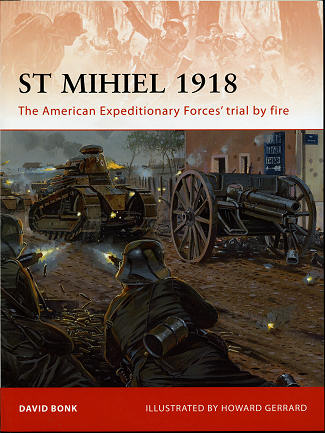 During
World War I, the Allies never were truly effective in their fight against the
Germans in Europe during most of the war. Thanks to the build up of trenches and
the ensuing stalemate of trench warfare, it was little more than a war of
attrition. Intense artillery bombardment, mass waves of troops wasting their
lives against nearly impenetrable fixed defenses, and the horrors of gas attacks
caused huge casualty rates.
During
World War I, the Allies never were truly effective in their fight against the
Germans in Europe during most of the war. Thanks to the build up of trenches and
the ensuing stalemate of trench warfare, it was little more than a war of
attrition. Intense artillery bombardment, mass waves of troops wasting their
lives against nearly impenetrable fixed defenses, and the horrors of gas attacks
caused huge casualty rates.
European armies were highly demoralized, none more than
the French, who had born the brunt of the losses. It was almost a godsend that
the United States declared war in April of 1917. But armies do not just show up
ready to fight the next day. It takes time to gather, equip and train soldiers,
then they need to be transported to the theater, something that takes time today
and something that took even more time in 1917.
The first US troops did not arrive in France until late
1917, and they were but the first of what had to be many. One did not win
battles in those days without a huge number of troops. Slowly, the American Army
learned by being attached to French and some British units. Tactics and
techniques had to be learned so the American Army trained and grew.
Meanwhile, the Germans realized they had to finish this
thing soon or they would be overwhelmed by American manpower. In March, they
started heavy activity and started pushing the British and French back towards
the Channel and Paris. This continued throughout the spring and summer. By the
late summer of 1918, the Germans had produced a salient or a bubble in the lines
that reached towards Paris at St. Mihiel. By this time, the US Army was built up
and trained well enough to be effective and after much political wrangling by
the US general in charge, John Pershing, was allowed to take part in the
offensive against the St. Mihiel salient as a unified American Army. This was
the first major battle of the 1st Infantry Division, the 'big red 1'.
This battle saw the first modern combat experience of
what would later become many of America's more famous generals. MacArthur,
Patton, and Marshall all participated in the St. Mihiel battle, with Patton able
to put into combat his tank brigades, gaining him experience that put him in
good stead 20 some years later. It is pretty amazing when you think about it.
The American Expeditionary Force fought as a cohesive unit for a mere 2 months,
yet had such a major outcome on the war.
The result of the battle was that the Germans were
pushed back a considerable distance and the salient cut off. Thanks to some less
than aggressive leadership, many of the German troops escaped the salient,
though they left behind equipment and stores in the process. Casualties were
high on both sides with an unusual number of men killed compared to the number
wounded. While it was a successful campaign, mistakes were made. The allied
French forces proved to be quite ineffective as most of the fighting and success
was undertaken by the American Army. It gave Pershing the respect his army
needed for following campaigns and showed the Germans that the end really was
near.
It is a fascinating account of this important battle and
quite detailed in terms of the build-up and unit movements during the short
campaign. This book is superbly illustrated by Howard Gerrard and contains a
goodly number of period photos. I have to admit that I found many of the images
small and so dark as to be difficult to see what was supposed to be in them. I
would recommend that Osprey look into adjusting the brightness/contrast and size
of their photos, something that anyone at home can do with their computer.
In all, a book I thoroughly enjoyed reading and I am
sure you will as well.
November 2011
For more on the complete line of Osprey books,
visit www.ospreypublishing.com. In the US, it is
Osprey Direct at 44-02 23rd St, Suite 219, Long Island City, NY 11101., where you can
get a catalogue of available books.
If you would like your product reviewed fairly and fairly quickly, please contact the editor or see other details in the Note to
Contributors.
 During
World War I, the Allies never were truly effective in their fight against the
Germans in Europe during most of the war. Thanks to the build up of trenches and
the ensuing stalemate of trench warfare, it was little more than a war of
attrition. Intense artillery bombardment, mass waves of troops wasting their
lives against nearly impenetrable fixed defenses, and the horrors of gas attacks
caused huge casualty rates.
During
World War I, the Allies never were truly effective in their fight against the
Germans in Europe during most of the war. Thanks to the build up of trenches and
the ensuing stalemate of trench warfare, it was little more than a war of
attrition. Intense artillery bombardment, mass waves of troops wasting their
lives against nearly impenetrable fixed defenses, and the horrors of gas attacks
caused huge casualty rates.